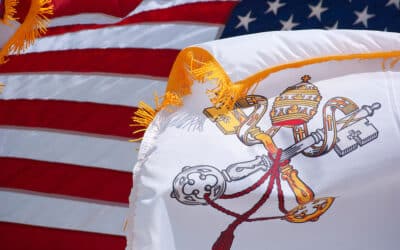About the Friars
DOMINICAN ORDER
The Order of Preachers
We are a Catholic men’s religious order established over 800 years ago by St. Dominic for preaching and the salvation of souls during a time when confusion was widespread and a clear articulation of the fullness of the truth was desperately needed.
Dominican Friars commit themselves to the four pillars of Dominican life—study, prayer, community life, and preaching—in order to be effective instruments of Jesus Christ’s saving mission.
OUR PROVINCE
The Province of Saint Joseph
The Province of St. Joseph, founded in 1805, is one of four Dominican provinces in the United States of America. It extends from New England down to Virginia, and west to Ohio and Kentucky. It is one of the fastest growing men’s religious communities in the United States, with over 50 men ordained to the priesthood over the past decade.
Our friars serve as university chaplains, professors, parish priests, hospital chaplains, itinerant preachers, and digital evangelists. Our ministries include a university, a pontifical faculty of theology, a nationwide network of campus chapters, and media apostolates with national and international reach.
OUR PROVINCE
The Province of Saint Joseph
The Province of St. Joseph, founded in 1805, is one of four Dominican provinces in the United States of America. It extends from New England down to Virginia, and west to Ohio and Kentucky. It is one of the fastest growing men’s religious communities in the United States, with over 50 men ordained to the priesthood over the past decade.
Our friars serve as university chaplains, professors, parish priests, hospital chaplains, itinerant preachers, and digital evangelists. Our ministries include a university, a pontifical faculty of theology, a nationwide network of campus chapters, and media apostolates with national and international reach.
OUR MINISTRIES
Preaching Truth in an Age of Confusion
People today are looking for answers to the big questions that are largely ignored in today’s educational system. Questions about the purpose of life, God’s existence, authentic happiness, and the relationship between faith and science are all being engaged by our university campus ministries, our burgeoning Thomistic Institute chapters on over 100 college campuses, our priests serving in parishes and as professors at universities, and through our many digital evangelization efforts, providing people a clarity uniquely offered by the Dominican Friars.
OUR PARISHES
Helping Families to Know and Love God
In our many parishes, Dominican friars serve families through teaching, preaching, and providing a rich sacramental and liturgical life, helping families to grow in the knowledge and love of God. Dominican friars provide robust faith formation to prepare young people for the vocation to which God calls them and to help parents continue to grow in their knowledge of the faith and support them as they live out their vocations as husbands, wives, and parents—seeking to provide them with an understanding of the task God has given them—to know and love God and to reveal God’s love to the world through their life as a family.
OUR PARISHES
Helping Families to Know and Love God
In our many parishes, Dominican friars serve families through teaching, preaching, and providing a rich sacramental and liturgical life, helping families to grow in the knowledge and love of God. Dominican friars provide robust faith formation to prepare young people for the vocation to which God calls them and to help parents continue to grow in their knowledge of the faith and support them as they live out their vocations as husbands, wives, and parents—seeking to provide them with an understanding of the task God has given them—to know and love God and to reveal God’s love to the world through their life as a family.
OUR FOUNDER
Saint Dominic
St. Dominic de Guzman (1170-1221) was a Spanish priest who was struck by the desperate need for an extended preaching campaign to present the people of his day with the fullness of the saving truth of Jesus Christ in light of the rampant heresy he encountered while travelling in southern France. He attracted men to join him in his mission of preaching and in 1216, Pope Honorius III formally approved the foundation of St. Dominic’s community. The pope addressed this new Order of Preachers as “Christ’s unconquered athletes” and bestowed upon them the mission of “preaching the word of God and proclaiming the name of our Lord Jesus Christ throughout the world.” St. Dominic served as the Master or superior of the entire Order until his death in 1221.
The Latest from the Friars
Dominican Saints 101: Bl. Pier Giorgio Frassati
Dominican Saints 101: Bl. Pier Giorgio Frassati “The Man of Beatitudes.” This was the name that...
Pious Patriotism
Pious Patriotism By Fr. Anthony VanBerkum, O.P. This day in the United States is often marked by...
Sharing in Your Master’s Joy
By Br. Gerard Rosario DeAngelis, O.P. Try as you may, whatever you are inside will eventually show...





